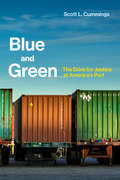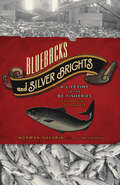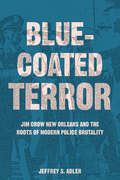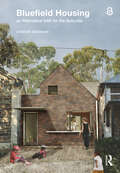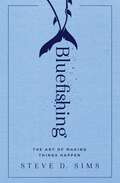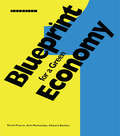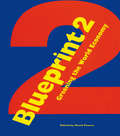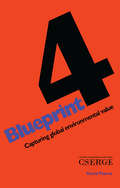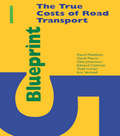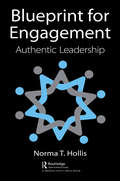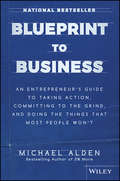- Table View
- List View
Blue Skies over Beijing: Economic Growth and the Environment in China
by Matthew E. Kahn Siqi ZhengOver the last thirty years, even as China's economy has grown by leaps and bounds, the environmental quality of its urban centers has precipitously declined due to heavy industrial output and coal consumption. The country is currently the world's largest greenhouse-gas emitter and several of the most polluted cities in the world are in China. Yet, millions of people continue moving to its cities seeking opportunities. Blue Skies over Beijing investigates the ways that China's urban development impacts local and global environmental challenges. Focusing on day-to-day choices made by the nation's citizens, families, and government, Matthew Kahn and Siqi Zheng examine how Chinese urbanites are increasingly demanding cleaner living conditions and consider where China might be headed in terms of sustainable urban growth. Kahn and Zheng delve into life in China's cities from the personal perspectives of the rich, middle class, and poor, and how they cope with the stresses of pollution. Urban parents in China have a strong desire to protect their children from environmental risk, and calls for a better quality of life from the rising middle class places pressure on government officials to support greener policies. Using the historical evolution of American cities as a comparison, the authors predict that as China's economy moves away from heavy manufacturing toward cleaner sectors, many of China's cities should experience environmental progress in upcoming decades.Looking at pressing economic and environmental issues in urban China, Blue Skies over Beijing shows that a cleaner China will mean more social stability for the nation and the world.
Blue Streak: Inside JetBlue, the Upstart That Rocked the Industry
by Barbara S. PetersonFive years ago an unknown entrepreneur named David Neeleman uprooted his wife and nine kids and moved from Utah to New York, dreaming of a bold new company that would make jaded travelers fall in love with flying again. Despite the recession and 9/11, he has succeeded beyond his wildest dreams. JetBlue Airways is consistently profitable, growing rapidly, and the clear winner in customer satisfaction ratings. Drawing on exclusive interviews with more than seventy-five insiders, Barbara Peterson weaves together a dynamic story of how JetBlue has blended outstanding customer service, inspirational leadership, savvy marketing, and disciplined financial management to come out on top.
Blue and Green: The Drive for Justice at America's Port (Urban and Industrial Environments)
by Scott L. CummingsHow an alliance of the labor and environmental movements used law as a tool to clean up the trucking industry at the nation's largest port. In Blue and Green, Scott Cummings examines a campaign by the labor and environmental movements to transform trucking at America's largest port in Los Angeles. Tracing the history of struggle in an industry at the epicenter of the global supply chain, Cummings shows how an unprecedented “blue-green” alliance mobilized to improve working conditions for low-income drivers and air quality in nearby communities. The campaign for “clean trucks,” Cummings argues, teaches much about how social movements can use law to challenge inequality in a global era.Cummings shows how federal deregulation created interrelated economic and environmental problems at the port and how the campaign fought back by mobilizing law at the local level. He documents three critical stages: initial success in passing landmark legislation requiring port trucking companies to convert trucks from dirty to clean and drivers from contractors to employees with full labor rights; campaign decline after industry litigation blocked employee conversion; and campaign resurgence through an innovative legal approach to driver misclassification that realized a central labor movement goal—unionizing port truckers.Appraising the campaign, Cummings analyzes the tradeoffs of using alternative legal frameworks to promote labor organizing, and explores lessons for building movements to regulate low-wage work in the “gig” economy. He shows how law can bind coalitions together and split them apart, and concludes that the fight for legal reform never ends, but rather takes different turns on the long road to justice.
Blue-Collar Cash: Love Your Work, Secure Your Future, and Find Happiness for Life
by Ken RuskA prescriptive and timely guide to finding success and happiness without a college degree by Ken Rusk, the Ohio-based entrepreneur and “million-dollar ditch digger” who believes it is time to celebrate the possibilities and financial opportunities that a Blue-Collar life can bring.A BLUE-COLLAR APPROACH TO CREATING A LIFE YOU LOVEIn a period of skyrocketing student loan debt without the promise of high-paying employment, and in an economy in desperate need of skilled tradespeople, many are seeking new paths. Ken Rusk, the “million-dollar ditch digger,” is here to show you that blue-collar trades are a source of pride and that you can—and will—find your version of happiness by pursuing a good old-fashioned craft. In Blue Collar Cash, Ken shares his insights from over 30 years working in blue collar trades as an entrepreneur, mentor, and life coach. Ken knows from his own experience—first as a young kid digging ditches, and then as the owner of a successful concrete construction business—that working with your hands at a job that takes skill and practice can be monumentally rewarding and life-affirming. Since then, he has built a multi-million-dollar business and gone on to mentor hundreds of employees in how to manage their money and set achievable goals. Using the stories of those who have discovered lives of comfort, peace, and freedom, Ken creates a step-by-step, interactive guide—including financial planning and savings advice—to creating alternative and realistic routes to success and fulfillment.
Blue-Collar Empire: The Untold Story of US Labor's Global Anticommunist Crusade
by Jeff SchuhrkeHow the CIA used American unions to undermine workers at home and subvert democracy abroadBlue-Collar Empire tells the shocking story of the AFL-CIO&’s global anticommunist crusade—and its devastating consequences for workers around the world.Unions have the power not only to secure pay raises and employee benefits but to bring economies to a screeching halt and overthrow governments. Recognizing this, in the late twentieth century, the US government sought to control labor movements abroad as part of the Cold War contest for worldwide supremacy. In this work, Washington found an enthusiastic partner in the AFL-CIO&’s anticommunist officials, who, in a shocking betrayal, for decades expended their energies to block revolutionary ideologies and militant class consciousness from taking hold in the workers&’ movements of Europe, Latin America, Africa, and Asia.
Blue-Green Rehabilitation: Urban Planning, Leisure and Tourism in River Cities
by Philip HaywardIn recent decades there has been a burgeoning interest in the development of blue-green corridors: areas where waterways are complemented by adjoining green spaces and related paths and leisure facilities. Urban planners have increasingly favoured such zones as a means of refreshing inner-city spaces. In many cases, such projects have involved the rehabilitation of former industrial and/or otherwise polluted waterways and adjacent land. These newly configured blue-green spaces have benefitted residents and provided a substantial attraction to tourists through in- and on- the water options (e.g., swimming, kayaking, fishing, cruise boat transit etc.), waterside relaxation and a range of riverbank activities. The establishment of managed green spaces has also seen the return of a variety of native species to such areas and the re-presentation of former waterside industrial features as heritage artefacts has also added value and appeal to such corridors. The anthology comprises nine international case studies that illustrate examples of best practice and/or the problems that can arise from such rehabilitations, such as gentrification (forcing housing prices up and dispersing established communities) and de-industrialisation that leads to reduced livelihood opportunities. Individual studies in the volume analyse the dynamics of neglect and rehabilitation, contrasting stakeholder agendas, destination branding and regional-national orientations. Collectively, the volume comprises an important reference point for future blue-green rehabilitation projects and the conclusion offers an agenda for the development of just and sustainable blue-green initiatives.
BlueVine Capital: Growth Factors
by Marco Di Maggio Nathaniel SchwalbThe start-up BlueVine Capital Inc. (BlueVine) used data and technology to help finance small businesses via factoring and lines of credit. The case explains the small business financing market in mid-2010s, how CEO Eyal Lifshitz identified the opportunity for BlueVine, and how he built the company through its first five years of operations. Through the case, Lifshitz and his team discover insights about their small business customers that inspire them to change their product portfolio. In December 2018, Lifshitz must decide which new products to launch next.
Bluebacks and Silver Brights: A Lifetime in the B.C. Fisheries from Bounty to Plunder
by Allan Safarik Norman SafarikA captivating memoir set during the pinnacle of West Coast fishingMore than a history of the Vancouver fishing industry, Bluebacks and Silver Brights is a collection of great adventures set on the Pacific coast. With dozens of salty tales of hardworking and hard-living fisherman and fish industry workers, this is Norman Safarik’s story of West Coast fishing from the Gulf of Georgia to Prince Rupert, with a detour to New York’s old-time fish markets. With wisdom and insight, Safarik’s story is also an ecological warning, recalling the lost bounty of Canada’s natural resources of a century ago, and their possible extinction today at the hands of government mismanagement and overfishing.
Bluecoated Terror: Jim Crow New Orleans and the Roots of Modern Police Brutality
by Jeffrey S. AdlerA searing chronicle of how racist violence became an ingrained facet of law enforcement in the United States. Too often, scholars and pundits argue either that police violence against African Americans has remained unchanged since the era of slavery or that it is a recent phenomenon and disconnected from the past. Neither view is accurate. In Bluecoated Terror, Jeffrey S. Adler draws on rich archival accounts to show, in narrative detail, how racialized police brutality is part of a larger system of state oppression with roots in the early twentieth-century South, particularly New Orleans. Wide racial differentials in the use of lethal force and beatings during arrest and interrogation emerged in the 1930s and 1940s. Adler explains how race control and crime control blended and blurred during this era, when police officers and criminal justice officials began to justify systemic violence against Black people as a crucial—and legal—tool for maintaining law and order. Bluecoated Terror explores both the rise of these law-enforcement trends and their chilling resilience, providing critical context for recent horrific police abuses as the ghost of Jim Crow law enforcement continues to haunt the nation.
Bluefield Housing as Alternative Infill for the Suburbs
by Damian MadiganSuburbanised cities share a common dilemma: how to transition to more densely populated and socially connected urban systems while retaining low-rise character, avoiding gentrification, and opening neighbourhoods to more diverse housing choices. Bluefield Housing offers a new land definition and co-located infill model addressing these concerns, through describing and deploying the types of ad-hoc modifications that have been undertaken in the suburbs for decades. Extending green-, brown-, and greyfield definitions, it provides a necessary middle ground between the ‘do nothing’ attitude of suburban preservation and the ‘do everything’ approach of knock-down-rebuild regeneration. An adjunct to ‘missing middle’ and subdivision densification models, with a focus on co-locating homes on small lots, Bluefield Housing presents a unified design approach to suburban infill: retrofitting original houses, retaining and enhancing landscape and urban tree canopies, and delivering additional homes as low-rise additions and backyard homes suited to the increasingly complex make-up of our households. Extensively illustrated by the author with engaging architectural design studies, Damian Madigan describes how existing quirks of suburban housing can prompt new forms of infill, explains why a new suburban densification model is not only necessary but can be made desirable for varied stakeholders, and charts a path towards the types of statutory and market triggers required to make bluefield housing achievable. Using Australian housing as an example but addressing universal concerns around neighbourhood character, demographic needs, housing diversity, dwelling flexibility, and landscape amenity, Bluefield Housing offers innovative suburban infill ideas for policy makers, planners, architects, researchers and students of housing and design studies, and for those with a stake in the future of the suburbs.
Bluefield Housing as Alternative Infill for the Suburbs
by Damian MadiganSuburbanised cities share a common dilemma: how to transition to more densely populated and socially connected urban systems while retaining low-rise character, avoiding gentrification, and opening neighbourhoods to more diverse housing choices. Bluefield Housing offers a new land definition and co-located infill model addressing these concerns, through describing and deploying the types of ad-hoc modifications that have been undertaken in the suburbs for decades. Extending green-, brown-, and greyfield definitions, it provides a necessary middle ground between the ‘do nothing’ attitude of suburban preservation and the ‘do everything’ approach of knock-down-rebuild regeneration.An adjunct to ‘missing middle’ and subdivision densification models, with a focus on co-locating homes on small lots, Bluefield Housing presents a unified design approach to suburban infill: retrofitting original houses, retaining and enhancing landscape and urban tree canopies, and delivering additional homes as low-rise additions and backyard homes suited to the increasingly complex make-up of our households.Extensively illustrated by the author with engaging architectural design studies, Damian Madigan describes how existing quirks of suburban housing can prompt new forms of infill, explains why a new suburban densification model is not only necessary but can be made desirable for varied stakeholders, and charts a path towards the types of statutory and market triggers required to make bluefield housing achievable. Using Australian housing as an example but addressing universal concerns around neighbourhood character, demographic needs, housing diversity, dwelling flexibility, and landscape amenity, Bluefield Housing offers innovative suburban infill ideas for policy makers, planners, architects, researchers and students of housing and design studies, and for those with a stake in the future of the suburbs.The Open Access version of this book, available at www.taylorfrancis.com, has been made available under a Creative Commons Attribution-Non Commercial-No Derivatives (CC-BY-NC-ND) 4.0 license.
Bluefin Labs: The Acquisition by Twitter
by John Deighton Leora KornfeldWhat is the value of Bluefin Labs's social listening data to Twitter? Acquired by Twitter in 2013, Bluefin had built a system that gathered millions of online comments in an effort to develop new metrics for TV programs and brand advertising. With data from Twitter and other social sites, expressions, not just impressions, could now be aggregated, measured, and used to calibrate brand performance and to sell media time. A second objective of the case is to understand the implications of social TV viewing, the audience engagement that results when people watch television with a smartphone or tablet in hand, participating in a virtual community of real-time TV watchers.
Bluefishing: The Art of Making Things Happen
by Steve D. SimsWhether it&’s climbing Everest, launching a business, applying for a dream job, or just finding happiness in everyday life, Steve Sims, founder of the luxury concierge service, Bluefish, reveals simple and effective ways to sharpen your mind, gain a new perspective, and achieve your goals.From helping a client get married in the Vatican, to charming and connecting with business mogul Elon Musk, Bluefish founder Steve Sims is known to make the impossible possible. Now, in his first book, he shares tips, techniques, and principles to break down any door and step onto whatever glamorous stage awaits you. By following Steve&’s succinct yet insightful advice—as well as inspiration gleaned from the moving stories of others—you, too, can transform your life and achieve the impossible.
Blueprint 1: For a Green Economy (Blueprint Series)
by David Pearce Anil Markandya Edward BarbierThis report has been prepared by the London Environmental Economics Centre (LEEC). LEEC is a joint venture, established in 1988, by the International Institute for Environment and Development (IIED) and the department of Economics of University College London (UCL). Popularly known as The Pearce Report, this book is a report prepared for the Department of the Environment. It demonstrates the ways in which elements in our environment at present under threat from many forms of pollution can be costed. The book goes on to show ways in which governments are able, as a consequence of this analysis, to construct systems of taxation which would both reduce pollution by making it too costly and generate revenue for cleaning up much of the damage. The book ends with a series of skeleton programmes for progress.
Blueprint 2: Greening the World Economy (Blueprint Series)
by David PearceFollowing 'Blueprint for a Green Economy' (the Pearce Report), David Pearce and his team have turned their attention to global environmental threats. If it makes sense to apply economic analysis to national environmental problems, then it makes even more sense to apply it to world-wide dangers. The authors start by describing the reasons for using economic approaches to common resources like climate, ozone and biodiversity. They then take a detailed look at the economic ways of tackling the issues involved in global warming, ozone layer depletion, environmental degradation in the Third World, population, rain forests, aid, equity, international environmental co-operation and what might amount to green foreign policies. They show not only how to take all these things into account in economic theory, but also the economic price of failing to do so. Blueprint 2 is an agenda for international and governmental economic action.
Blueprint 3: Measuring Sustainable Development (Blueprint Series)
by David PearceBlueprint 3 is the direct sequel to the ground-breaking Blueprint for a Green Economy. Taking the argument much further, David Pearce and his colleagues show how progress towards sustainability in the UK can be measured. They set out the conditions for sustainable development and the measures of economic progress these imply, before looking in detail at all the main areas of economic activity to which the measures are applicable. The result is a wide-ranging and cogent critique of existing policies which also offers new options - options which will require far-reaching reform of this country's existing political and institutional structure. Blueprint 3 will be a touchstone for future discussions of all the major policy areas.
Blueprint 4: Capturing Global Environmental Value (Blueprint Series)
by D.W. PearceBlueprint 4 continues the theme of Blueprint 2 in looking at the opportunities for using market forces for environmental ends. It assesses a range of possible imaginative 'global bargains', which give all parties a self-interested incentive to improve the global environment. The book begins by reviewing the principle global issues to be addressed, and then explains the mechanisms of resource degradation: how economic systems fail, the operation of trade on the environment and the effects of population growth and consumption patterns. It then shows how environmental value can be captured, and the basis, means and institutions for doing so.
Blueprint 5: True Costs of Road Transport (Blueprint Series #Vol. 5)
by David Pearce Olof Johansson David MaddisonEvidence has come to light regarding the impact of benzene emissions from road transport, the incidence of asthmatic attacks and the possible toll of particulate matter from diesel engines on human health. This book examines the issues and argues that, without a fundamental change in policy, it is inevitable that the transport sector will continue to impose increasing costs on the natural environment, human health and the economy. It also quantifies the external costs of road transport and suggests new measures, such as road pricing and financial incentives, to pave the way to a sustainable transport system.
Blueprint for Engagement: Authentic Leadership
by Norma T. HollisAuthentic leadership is an approach to leadership that emphasizes building the leader’s legitimacy through honest relationships with followers which value their input and are built on an ethical foundation. By building trust and generating enthusiastic support from their subordinates, authentic leaders are able to improve individual and team performance. Many scholars and practitioners of authentic leadership say that the number one quality of an authentic leader is self-awareness. Self-aware leaders are transformational. Armed with self-awareness they build engaging, cooperative teams. How to gain and sustain self-awareness is the focus of the book. This book addresses current leadership challenges in health care and gives leaders guidelines for finding, living and sharing their authentic voice at home and at work. It is a much needed handbook to give current leaders perspective and practical tips to being more authentic, communicating more effectively while building engaging rapport across the organization. Additionally, a focus of the book is patient satisfaction. With a focus on nurse and physician leadership, this book provides new perspectives and action plans to increase patient satisfaction through communication that speaks to the needs of the patient in authentic and engaging ways.
Blueprint for Project Recovery--A Project Management Guide: A Project Management Guide : The Complete Process For Getting Derailed Projects Back On Track
by Ronald B. CagleWith the acceleration of technology and information, projects are becoming more complex, costly, and time-constrained -- and every year thousands of them get cancelled or end up costing significantly more than their original projections. Project and program managers are sorely in need of tools to help them avoid failure. Blueprint for Project Recovery provides readers with a proven, proceduralized methodology for identifying where and how projects went off course, and a defined plan of action to bring them back on track. Based on years of research and including a CD-ROM packed with all the forms, checklists and resources used in the text, the book gives readers an entire process for both evaluating and repairing projects gone off course, and guidance for planning them more effectively in the first place. The book is designed as an easy reference troubleshooting guide that readers can use immediately to solve all their project difficulties. Every project or program has exigencies that can cause problems with cost, schedule, or outcome. Blueprint for Project Recovery! is the ultimate antidote.
Blueprint for Success: Spend More on Training
by Jeffrey PfefferA country's or a company's competitive advantage in the current global economy depends primarily on its people's skills, talent, and educational attainment. This chapter outlines the steps that companies can, and must, take in order to nurture the human capital needed for long-term success.
Blueprint to Business: An Entrepreneur's Guide to Taking Action, Committing to the Grind, And Doing the Things That Most People Won't
by Michael AldenEssential reading for any would-be entrepreneur Blueprint to Business is the ultimate guide to becoming a successful entrepreneur. Bestselling author and CEO Mike Alden puts aside the rainbows and sunshine, gets real about what it takes to 'make it,' and gives you the real-world guidance you need to hear. Through anecdotes and advice, he shares his experiences along with those of other top founders and entrepreneurs to give you a realistic picture of what it takes to build a business. It's a bit of tough love, a healthy dose of reality, and a tremendously motivating guide to striking out on your own; from motivation and commitment to business licenses and the IRS, this guide is your personal handbook for the biggest adventure of your career.



